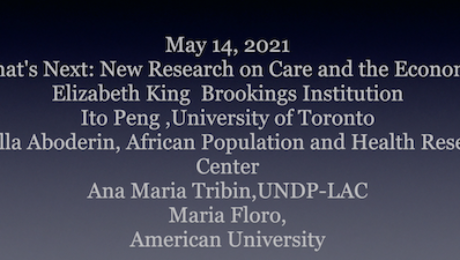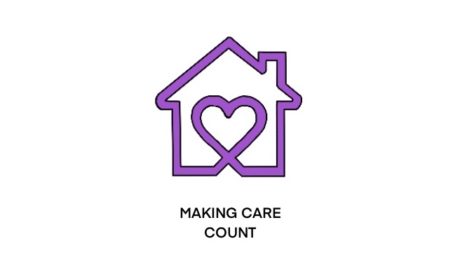The Next Steps for Research on Care and the Economy
The third day of the Concluding Annual Meeting was marked by reflection of the project and sharing research plans for the future. Dr. Ito Peng (University of Toronto) introduced the next step of research that is taking a wider, global lens and then Dr. Isabella Aboderin (Perivoli Africa Research Centre) and Dr. Ana Maria Tribin (Central Bank of Colombia) gave details about the context and goals for the region they are concentrating on for the project.
The next leg of the project will be based at the University of Toronto, and it will scale up the research to a global and comparative level. It will aim to adapt methods used for South Korea and innovate new methods in order to study eight countries from four separate regions around the world. For each country/region, they plan to conduct two large surveys, a time use and an interview survey about care giving and receiving. This multi-country approach will enable the researchers to produce detailed and nuanced data and insights and be able to see the interaction of the care economy with different cultures and policies.
The data collection and research will be spearheaded by grassroots organizations and native researchers. Dr. Aboderin emphasized the goal of the African branch of the project is to generate Africa-centered knowledge about the importance of early childhood and long-term care. As for the Latin America portion of the project, specifically Colombia, Dr. Tribin spoke about the need to provide the public and policy makers with qualitative and quantitative tools and data to understand the large gender gaps in the labor market in the region.
To hear the full discussion and learn more details about the next steps of the project, see below.
Written by Catherine Falvey, Research Assistant for the Care Work and the Economy project and PhD student in Economics at American University
- Published in Conferences, Expert Dialogues & Forums, Maria Floro, Policy, Research
“Girly Issues” Are Now the Country’s Issues
Dr. Nancy Folbre, an Advisor and Researcher of the CWE-GAM project and a groundbreaking feminist economist was among the first to sound the alarm about the care crisis. Dr. Folbre’s work on the care sector, once considered “just girly issues” by fellow economists, are now recognized as issues belonging to the U.S.. Previously the recipient of the 1998 MacArthur “genius” grant, Dr. Folbre’s research has journeyed from “fringe idea to more mainstream policy.”
Once cast aside in policy discussions, the care crisis is finally getting the spotlight it deserves after the pandemic forced many schools and child-care centers to close, leaving “ten million mothers of school-age children out of the workforce.” The pandemic is forcing policymakers to finally face the cracks in America’s care infrastructure that Dr. Folbre and other experts have long pointed out— “a system where working parents do not have reliable, affordable child care is one where they cannot reliably build a career.”
To learn more about Dr. Folbre’s work on care, visit her blog Care Talk and read her recent book The Rise and Decline of Patriarchal Systems.
This blog was authored by Lucie Prewitt, a research assistant for the CWE-GAM project.
- Published in Child Care, COVID 19, Economic Recovery, Feminist Economics
Making Care Count
The COVID-19 pandemic has informed our understanding of the care economy, exposing disproportionate inequities that must be addressed to alleviate the international erasure of care workers. These issues are addressed in the latest Susan and Michael J. Angelides Lecture, in which Naomi Klein moderates a discussion between Congresswoman Pramila Jayapal and CWE-GAM researcher Dr. İpek İlkkaracan on COVID-19 and the care economy.
We live in an economic system that has traditionally deprioritized and invisibilized care workers, many of which are women of color, migrant, and poor women. The economic crisis brought on by the pandemic has consequently given policymakers and academics “a once-in-a-generation opportunity to address [the valuation of care work] from an intersectional [approach],” states Congresswoman Jayapal.
The Care Crisis Exposed by the Pandemic Recession:
When mass unemployment hit during the pandemic, the cracks in the economic infrastructure of America began to show. As millions of people lost their jobs, the highest increase in the number of uninsured Americans was subsequently recorded. This high number of uninsured people is a direct consequence of healthcare being employer-sponsored. Congresswoman Jayapal notes that “Medicare For All would have strengthened the response to the pandemic…30 percent of COVID-19 deaths were related to a lack of insurance.”
While gains were made in the past decade in regards to gender equality in the workplace, Congresswoman Jayapal notes that “as soon as the pandemic hit, it was the women who went back to taking care of [their] families.” Dr. İpek İlkkaracan explains that this is because “the nature of women’s employment is often determined by their care responsibilities…unpaid care work is often articulated as one of the most significant barriers to labor force participation.” This notion was reflected in jobs reports—in December of 2020, women accounted for 100 percent of job loss, and within that, 154,000 Black women exited the workforce.
In its current state, the care economy produces a pattern of inequality that disproportionately affects women of color and migrant women. The average caregiver salary is $12.74, and the care work sector is marked by poor working conditions with no adequate social protections and low wages. This is why, as Congresswoman Jayapal notes, the fight for one fair wage is pertinent. “An increase in the minimum wage would give 32 million workers a raise, 60 percent of which are women while 1 in 4 of the women who would benefit from this increase are Black or Latina.”
A Framework for a More Caring Economy:
Dr. İpek İlkkaracan has developed a framework that acknowledges the care economy. This framework, coined as the Purple Economy (a nod to the color representative of many women’s movements), envisions a gender-egalitarian and caring economic system. Dr. İlkkaracan recommends “labor market regulations and investment in care services such as long-term care, early childhood education, education, and healthcare” as policy interventions to start the process of adequately valuing care.
Not only is investment in care important from a humanitarian and ethical perspective, but it is also conducive to economic stability. Dr. İlkkaracan’s research has revealed that investment in care services produces a high employment multiplier: for every dollar invested in care, three times as many jobs are created in the wider economy. This is because the care sector is intertwined with other sectors such as food, transport, and financial services. In the Asia-Pacific region, Dr. İlkkaracan’s research has shown that “up to four trillion dollars could be added to GDP if unpaid care work (75% of which done by women) was valued in market terms.” While this may seem astronomical, the amount of unpaid work completed globally in one day equates to 16.4 billion hours—which translates to two billion full-time jobs. Dr. İlkkaracan’s recent research also reveals that a “3.5-4% commitment of GDP to investment in care services would create 120 million additional jobs and have a large impact on poverty alleviation.”
To watch the full conversation and learn more about the Purple Economy, see below.
Dr. İpek İlkkaracan is a CWE-GAM researcher a part of the Rethinking Macroeconomics and Gender Aware Applied Economics Working Groups.
This blog was authored by Lucie Prewitt, a research assistant for the CWE-GAM project.
- Published in Child Care, COVID 19, Economic Recovery, Gender-Equal Economy, Policy, Rethinking Macroeconomics, U.S.
What is the Care Economy and Why Should We Care?
In our project, we aim to promote and advocate for gender and socioeconomic equalities. We do this by working to reduce gender gaps in economic outcomes and by showing and properly valuing social and economic contributions of caregivers; and integrating care into macroeconomic policy making toolkits.
In this era of demographic shifts, economic change and chronic underinvestment in care provisioning, innovative policy solutions are desperately needed, now more than ever. Sustainable and inclusive development requires gender-sensitive policy tools that integrate new understandings of care work and its connections with labor market supply and economic and welfare outcomes.
The Care Work and the Economy Project, currently based at the Economics Department of American University and co-led by Maria S. Floro and Elizabeth King, includes more than 30 scholars around the globe, working closely together to provide policy makers, scholars, researchers and advocacy groups with gender-aware data, empirical evidence and analytical tools needed to promote creative macroeconomic and social policy solutions. In the next phase of the project, Care Economies in Context, we will be scaling up our project to include 8 different countries, in 4 global regions. I will be leading this next phase of the project, which will be based at the University of Toronto.
I define Care work is defined broadly as work and relationships that are necessary for the health, welfare, maintenance and protection of all people – young and old, able bodied, disabled, and frail. This definition may seem broad – but care– at its core is a very basic human need and a necessity. Whether we know it or now, we all participate in providing care work – paid or unpaid, and in receiving care every day.
By care economy, I am referring to the sector of economy that is responsible for the provision of care and services that contribute to the nurturing and reproduction of current and future populations. More specifically, it involves child care, elder care, education, healthcare, and personal social and domestic services that are provided in both paid and unpaid forms and within formal and informal sectors.
Care work is important because it is important work that sustains life. It is also important now in particular because it is one of the fastest expanding economic sectors and a major driver of employment growth and economic development around the world. For example, across the OCED, the service sector economy now accounts for over 70 percent of total employment and GDP. In lower- and middle-income countries, it is estimated to comprise nearly 60 percent of GDP. Within the service sector economy, care services is one of the fastest growing subsectors.
The International Labour Organization (ILO) estimates that the global employment in care jobs is expected to grow from 206 million to 358 million by 2030 simply based on sociodemographic changes. The figure will be even more dramatic to 475 million if governments invest resources to meet the UN sustainable development goal targets on education, health, long-term care and gender equality.
In Canada, the service sector already makes up for 75 percent of employment and 78 percent of GDP. Within this sector, healthcare, social assistance and education services are key drivers of economic and employment growth. In the U.S., healthcare is already the largest employer, larger than steel and auto industries put together. In short, our current and future economy is and will be increasing dominated by care services and care work.
However, at the same time, much of the care work continues to be performed for no pay, by families and friends, at home and in communities. This unpaid care work is not including in in our national GDP because GDP only takes into account work that is done for pay in the formal market. Therefore, if we only look at the GDP as a measure of the economy and economy growth, we miss a huge segment of the economy and economic activities. As the pandemic has shown, without both paid or unpaid care work, our economy will not be able to function effectively, nor would it be able to sustain itself.
What we are trying to do in our project is to make the care economy clearer and more visible by measuring and mapping out the size and shape of the economy, and to develop macroeconomic models that would help policymakers and civil society actors to develop better policies and better strategies to ensure more sustainable and equality inducing economic growth.
Listen to the full talk “The Care Work and the Economy Project” to learn about what the care economy is and why we should know more about it, particularly now.
The blog was authored by Ito Peng, contributing researcher for the Understanding and Measuring Care research cluster
- Published in Canada, Child Care, Economic Modeling, Elder Care, Expert Dialogues & Forums, Feminist Economics, OECD
Making the Biden-Harris Economic Recovery Plan Gender Responsive
A recent Gender & COVID-19 brief (also a sign on letter) “Making the Biden-Harris Transition Plan for COVID-19 gender-responsive” outlines how the Biden-Harris Transition Plan in the US can be made more gender-responsive. The brief is a starting point in highlighting the potential within the Biden-Harris Transition Plan, using economic recovery as an entry point, with recommendations based on the best practices for feminist economic recovery from COVID-19.
The Biden-Harris Economic Recovery Plan is constructed around four challenges which must be overcome to rebuild the nation. The brief applies a gender lens for each challenge, emphasizing that for these efforts to be truly equitable, it is critical that they are not implemented in isolation and an intersectional gender lens is used in policy making and interventions.
- Mobilize American manufacturing and innovation to ensure that the future is made in America, and in all of America: Targeted support to business owners from under-represented groups in the forms of emergency funds, skills, training and mentorship; and direct funding to businesses in women-majority sectors, including caregiving and social enterprises, should be a centerpiece of the policy.
- Mobilize American Ingenuity to build a modern infrastructure and an equitable, clean equitable future: Investment in care infrastructure is also green, as it supports jobs for women (in the care sector) and men (in the construction sector), and provides services communities need to thrive. Implementing stimulus programs focused on ‘green jobs’ should proactively plan for gender equity and include formal programming for women, with special emphasis on displaced workers, communities of color, and women who are in recovery from incarceration.
- Mobilizing American talent and heart to build a 21st century caregiving and education workforce: Prioritize universally accessible, free (or highly subsidized) childcare and long-term elder care as central to its economic recovery plan. This can in part be accomplished through the designation of direct public funds to existing regulated and licensed care services. Direct public funds should also be used to invest in measures to keep workers safe and expand the number of care spaces available. Importantly, many workers who provide the backbone of the care economy are informally employed, wherein they have limited or no access to social protection. As such, government assistance schemes should be expanded to include family and informal caregivers, and an expedited path to permanent resident status should be created for precarious immigrant care workers so that they can access those schemes. This has a much greater effect than simply creating employment in the care sector but facilitates women’s participation across the economy.
- Mobilize across the board to advance racial equity in America: There can be no gender justice while there is racial injustice. Racial and gender inequities are inextricably linked to the economy. For example, Black, racialized, and immigrant women are disproportionately represented as personal support workers, cleaners, and in other essential but low-paid occupations – many of which are in the informal economy – that do not provide paid sick leave or family leave.
READ FULL BRIEF: Solomon A, Morgan R, Wenham C, Smith J, Nacif Pimenta D, Mueller V, Herten-Crabb A and Hawkins K (2020) Making the Biden-Harris Transition Plan for COVID-19 gender-responsive, Gender and COVID-19 project
This blog was authored by Jenn Brown, CWE-GAM Communications Assistant





